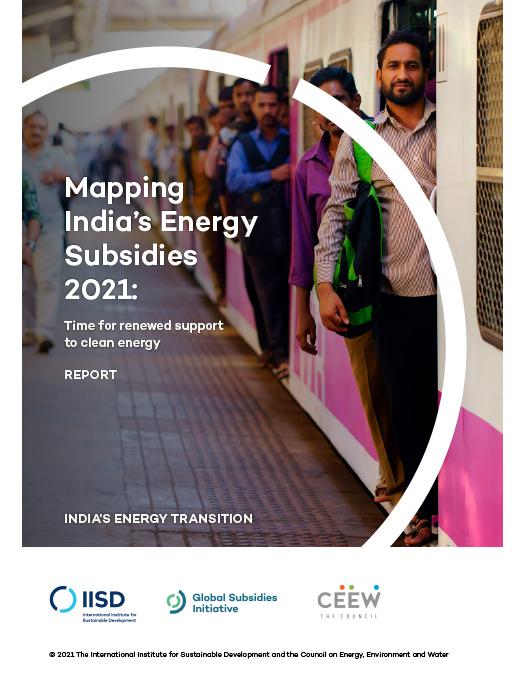Report
Mapping India’s Energy Subsidies 2021
Time for Renewed Support to Clean Energy
Balasubramanian Viswanathan, Anjali Viswamohanan, Prateek Aggarwal, Danwant Narayanaswamy, Anna Geddes, Theresia Betty Sumarno, Max Schmidt, Christopher Beaton, Siddharth Goel, Arjun Dutt, Karthik Ganesan
July 2021 |
Suggested Citation: Viswanathan, Balasubramanian, Anjali Viswamohanan, Prateek Aggarwal, Danwant Narayanaswamy, Anna Geddes, Theresia Betty Sumarno, Max Schmidt, Christopher Beaton, Siddharth Goel, Arjun Dutt, Karthik Ganesan. 2021. Mapping India's Energy Subsidies 2021 – Time for renewed support to clean energy. Winnipeg: International Institute for Sustainable Development.
Overview
This study, published in collaboration with IISD, examines how the Government of India has used subsidies to support different types of energy from FY 2014 until FY 2020. It draws on qualitative data to describe major shifts since the onset of COVID-19. The subsidies have been categorised into five groups: coal; oil and gas (O&G); electricity transmission and distribution (T&D); renewable energy (RE); and electric vehicles (EVs). All categories include the full value chain of production and consumption.
In light of the government commitments to Aatmanirbhar Bharat (self-reliant India), the study also includes two special thematic chapters. The first explores how subsidy policy can best promote solar photovoltaic (PV) manufacturing as part of the road to 450 GW of renewable energy by 2030. The second examines how investments by public sector undertakings (PSUs) are supporting clean energy.
The report is the latest update in a series of reviews of India’s energy subsidies - Mapping India’s Energy Subsidies 2020 Update, India’s Energy Transition 2018 and India’s Energy Transition 2017.
Key Findings
Subsidies
- Total quantified energy subsidies have decreased by 30 per cent from INR 297,876 crore in FY 2014 to INR 209,552 crore in FY 2020.
- Fossil fuel subsidies were 7.3 times larger than subsidies for clean energy in FY 2020.
- Energy subsidies to electricity transmission and distribution form the largest share of the total subsidy quantified, accounting for INR 129,256 crore in FY 2020.
- Coal subsidies have been steadily declining since FY 2014, but still remain 1.74 times higher than the renewable energy subsidies.
- In FY 2021, several non-subsidy measures, such as withdrawing or pushing back environmental regulations despite health impacts for citizens, were implemented to incentivise domestic coal production.
- Oil and gas subsidies increased 16 per cent from FY 2019 to FY 2020, reaching INR 55,347 crore. Kerosene subsidies are to be removed by FY 2022, completing a successful phase-out.
- In FY 2020, subsidies for renewables saw little change from FY 2019, but have fallen by 45 per cent from a high of INR 15,470 crore in FY 2017 to INR 8,577 crore. In part, this reflects the increasing competitiveness of solar PV and wind power, and in part, a slowdown in deployment levels.
- Since FY 2019, EV subsidies have risen more than 2.3 times, reaching INR 1,141 crore in FY 2020, primarily driven by growing sales in the two wheeler segment.
Solar PV deployment and manufacturing
- Policy certainty is key to mobilising finance for solar PV projects. Policies would need to address ongoing and future risks faced by developers, particularly those associated with off-take, land, and grid integration.
- India’s solar manufacturing lacks international competitiveness because of smaller scale, lower capacity utilisation of facilities and limited backward integration. Creating demand-side certainty is essential to trigger new investments in expansion and backward integration of existing capacity.
PSUs ambitions
- From FY 2014 to FY 2020, the seven energy-related Maharatna-level PSUs invested INR 2.5 lakh crore (USD 35.5 billion) (in nominal terms) in 183 projects.
- The focus was 11 times more investment in fossil fuel than clean energy projects in FY 2020.
- The seven PSUs have relatively low ambition on clean energy and no planning on how to manage the stranded asset risk of fossil-intensive asset portfolios.
Key Recommendations
- Identify, design, and implement a new generation of support measures for clean energy. The focus should be on improving grid integration, promoting decentralised renewable energy adoption for industries and rural livelihoods, adopting advanced storage solutions, incentivising EVs and investing in future clean technologies.
- Resolve discom finances by implementing stable, systemic and sustainable changes and make them future-ready to serve the fast growing economy.
- Capture the social and environmental costs of coal power and utilise them for the just transition, healthcare and social protection.
- Target fiscal and financial incentives via cheaper electricity & product linked incentive schemes to improve plant-level economics and competitiveness of solar PV manufacturing.
- Provide incentives to increase R&D investments all along the manufacturing chain so that solar PV manufacturers can compete globally on technological advancements and quality.
- The government must provide a clear clean energy mandate for India’s PSUs. PSU must set high ambitions towards funding clean energy and establishing national manufacturing capacities by adopting diversified business models.
Fossil fuel subsidies were 7.3 times larger than subsidies for clean energy in FY 2020. Coal subsidies have been steadily declining since FY 2014, but still remain 1.74 times higher than the renewable energy subsidies.





